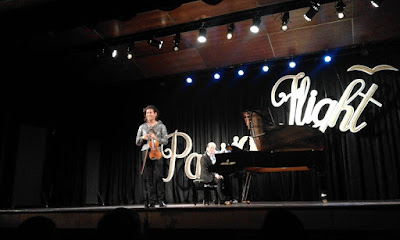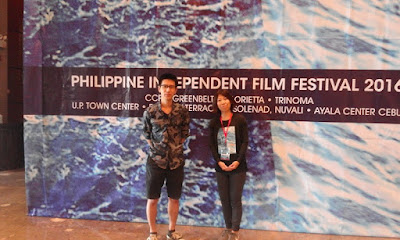While the protest rallies were happening in various parts of the country, I took solace to music as a way to distract my weary self from all the political drama by catching Passion Flight that featured violinist Iskandar Widjaja and pianist Itamar Golan who were both making their Philippine debuts.
Thoughts of the tense political climate took a back seat
right away once the opening act, a dozen Suzuki kids, took to the stage for
their rendition of Twinkle, Twinkle Variations. And while the intonation was a
bit all over the place, there was still cuteness overload with the kids beaming
on stage as if they were the main act.
The main acts, Berlin based
Iskandar, sporting a recent tan and dressed more like movie star rather than a
classical musician and Itamar, looking dapper in a sleek suit quickly eased the
audience with an appetizer of a piece, Fritz Kreisler’s Tempo di Minuetto in
the style of Pugnani. Then following right after was Cesar Franck’s Sonata in A
Major, a large scale work that showed the breadth and depth of Iskandar’s
capabilities. Instinctively, I got drawn to the pianist Itamar, who exuded
confidence giving me the feeling that he and Iskandar were communicating
telepathically and that they will be in sync all throughout the concert.
I finally got to focus on Iskandar
as the spotlight was solely on him when he tackled Johann Sebastian Bach’s Chaconne
from Violin Partita No. 2 in D minor, BWV 1004. Very commendable was his
clarity and consistency making each line and layer sing distinctly and smoothly.
In less capable violinists, the result is usually a muddled jumble of notes
without any direction. My only gripe with Iskandar’s take was that it had too
much attack and it sounded too aggressive.
Refreshed after the interval, the
duo gave a more relaxed George Frideric Handel’s Violin Sonata in D Major HWV
371, brilliantly fleshing out the melodies with a bit more restraint compared
to that of the pieces of the first half. My most eagerly anticipated moment in this concert was
hearing Arvo Pärt’s Spiegel im Spiegel live for the first time. With lights
dimmed for a bit of theatrics during this portion, it was hypnotic and haunting
to hear such music, sparse on paper and yet so difficult to play effectively. I
initially wondered how the audience would react to music that is devoid of any
fireworks but the applause that followed soon after just allayed my fears.
I was really expecting Jascha Heifetz’
transcription of Porgy and Bess to be performed but hearing the short piano
introduction told me that this was not the case. Instead, what I heard was a
single movement fantasy work that showcased loads of virtuosic moments from
Iskandar that was accompanied by Itamar playing jazzy chords that sounded so
deliciously rich. It was only later on that I learned from Iskandar that this
piece, the Concert Fantasy on Themes from Porgy and Bess, Op. 19, was actually by
Igor Alexandrovich Frolov. I also learned that one violinist who was among the
audience was planning to give the Philippine premiere of this piece sometime next
year. Too bad for him that Iskandar and Itamar already beat him to it. But I
would definitely want to hear this Frolov piece again.
Overall, the first half felt to me that Iskandar pushed too much, too overt, and almost going over the top in both the Franck sonata and the Chaconne. This made the restraint he exhibited at the second half a much welcome change of pace. Ultimately, this effectively built the momentum towards a dazzling finale.
Passion Flight featuring violinist Iskandar Widjaja and pianist
Itamar Golan was presented by the Philippine Suzuki Association in cooperation
with St. Paul University, Manila.






















